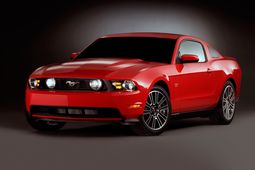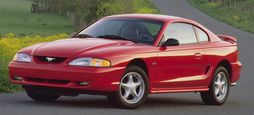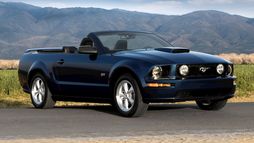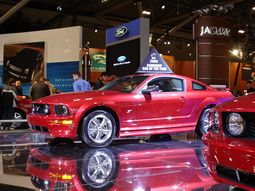The History Of FORD Mustang

The Ford Mustang is an automobile manufactured by the Ford Motor Company. It was initially based on the Ford Falcon, a compact car. Production began in Dearborn, Michigan on 9 March, 1964 and the car was introduced to the public on 17 April 1964 at the New York World's Fair.
It was Ford's most successful launch since the Model A.
Executive stylist John Najjar, who was a fan of the World War II P-51 Mustang fighter plane, suggested the name.
The Mustang created the "pony car" class of American automobile — sports car-like sedans with long hoods and short rear decks —and gave rise to competitors such as GM's Camaro, AMC's Javelin, and Chrysler's revamped Barracuda. It also inspired coupés such as the Toyota Celica and Ford Capri, which were exported to America.
Mustangs grew larger and heavier with each model year until, in response to the 1971-1973 models, fans of the original 1964 design wrote to Ford urging a return to its size and concept.
Although some other pony cars have seen a revival, the Mustang is the only original pony car that has remained in production without interruption after four decades of development and revision.
Main article: First-generation Ford MustangConceived by Ford product manager Donald N. Frey and championed by Ford Division general manager Lee Iacocca, the Mustang prototype was a two-seat, front-mounted engine roadster. This would later be remodeled as a four-seat car penned by David Ash and John Oros in Ford's Lincoln–Mercury Division design studios, which produced the winning design in an intramural design contest instigated by Iacocca. To cut down the development cost and achieve a suggested retail price of US$2,368, the Mustang was based heavily on familiar yet simple components. Much of the chassis, suspension, and drivetrain components were derived from the Ford Falcon and Ford Fairlane (North American). Favorable publicity articles appeared in 2,600 newspapers the next morning, the day the car was "officially" revealed. A Mustang also appeared in the James Bond film Goldfinger in September 1964, the first time the car was used in a movie.
Original sales forecasts projected less than 100,000 units for the first year, but in its first eighteen months, more than one million Mustangs were built.
Main article: Second-generation Ford MustangThe 1970s brought about more stringent pollution laws and the OPEC oil embargo. As a result, large, fuel-inefficient cars fell into disfavor, and the Pony Cars were no exception. Lee Iacocca, who became president of the Ford Motor Company in 1964 and was the driving force behind the original Mustang, ordered a smaller, more fuel-efficient Mustang for 1974. Initially it was to be based on the Ford Maverick, but ultimately was based on the Ford Pinto subcompact.
The new model was introduced two months before the first "Energy Crisis" in October 1973, and its reduced size allowed it to compete more effectively against smaller imported sports coupés such as the Japanese Toyota Celica and the European Ford Capri (then Ford-built in Germany and Britain, sold in U.S. by Mercury as a captive import car). First-year sales were 385,993 cars, compared with the original Mustang's twelve-month sales record of 418,812.
Lee Iacocca wanted the new car, which returned the Mustang to more than a semblance of its 1964 predecessor in size, shape, and overall styling, to be finished to a high standard, saying it should be "a little jewel." However not only was it smaller than the original car, but it was also heavier, owing to the addition of equipment needed to meet new U.S. emission and safety regulations. Performance was reduced, and despite the car's new handling and engineering features the galloping mustang emblem "became a less muscular steed that seemed to be cantering."
The car was available in coupé and hatchback versions. Changes introduced in 1975 included reinstatement of the 302 CID V8 option (called the "5.0L" although its capacity was 4.94L) and availability of an economy option called the "MPG Stallion". Other changes in appearance and performance came with a "Cobra II" version in 1976 and a "King Cobra" in 1978.
Main article: Third-generation Ford MustangThe 1979 Mustang was based on the larger Fox platform (initially developed for the 1978 Ford Fairmont and Mercury Zephyr). The interior was restyled to accommodate four people in comfort despite a smaller rear seat. The trunk was larger, as was the engine bay, for easier service access.
Body styles included a coupé (notchback) and hatchback; a convertible was offered in 1983. Available trim levels included L, GL, GLX, LX, GT, Turbo GT, SVO (1984-86), and Cobra and Cobra R (1993).
In response to slumping sales and escalating fuel prices during the early 1980s, a new Mustang was in development. It was to be a variant of the Mazda MX-6 assembled at AutoAlliance International in Flat Rock, Michigan. Enthusiasts wrote to Ford objecting to the proposed change to a front-wheel drive, Japanese-designed Mustang without a V8 option. The result was a major facelift of the existing Mustang in 1987, while the MX-6 variant became the 1989 Ford Probe.
Main article: Fourth-generation Ford MustangIn 1994 the Mustang underwent its first major redesign in fifteen years. Code named "SN-95" by Ford, it was based on an updated version of the rear-wheel drive Fox platform called "Fox-4." The new styling by Patrick Schiavone incorporated several styling cues from earlier Mustangs. For the first time a notchback coupe model was unavailable.
The base model came with a 3.8 OHV V6 (232cid) engine rated at 145 hp (108kW; 1994-1995) or 150hp (112kW; 1996-1998) and was mated to a standard 5-speed manual transmission or optional 4-speed automatic. Though initially used in the 1994 and 1995 Mustang GT, Ford retired the 302cuin (4.94889L) overhead-valve small-block V8 after nearly 40 years of use, replacing it with the newer Modular 4.6L (281cid) SOHC V8 in the 1996 Mustang GT. The 4.6L V8 was initially rated at 215hp (160kW; 1996-1997) but was later increased to 225hp (168kW; 1998).
For 1999, the Mustang received Ford's New Edge styling theme with sharper contours, larger wheel arches, and creases in its bodywork, but its basic proportions, interior design, and chassis remained the same as the previous model. The Mustang's powertrains were carried over for 1999 but benefitted from new improvements. The standard 3.8L V6, thanks to a new split-port induction system, now produced 190hp (142kW; 1999-2004) while the Mustang GT's 4.6L V8 saw an increase in output to 260hp (194kW; 1999-2004), thanks to a new head design and other enhancements. There were also two alternate models offered in this generation that included the 2001 Bullitt GT and the 2003 and 2004 Mach 1.
Main article: Fifth-generation Ford MustangAt the 2004 North American International Auto Show, Ford introduced a completely redesigned Mustang, codenamed "S-197," that was based on an all-new D2C platform for the 2005 model year. Developed under the direction of Chief Engineer Hau Thai-Tang and exterior styling designer Sid Ramnarace, the fifth-generation Mustang's styling echoes the fastback Mustangs of the late 1960s. Ford's senior vice president of design, J Mays, called it "retro-futurism."
The fifth-generation Mustang is manufactured at the AutoAlliance International plant in Flat Rock, Michigan. The base model is powered by a 210hp (157kW) cast-iron block 4.0 L SOHC V6, which replaces the 3.8L pushrod V6 used previously. The Mustang GT features an aluminum block 4.6L SOHC 3-valve Modular V8 with variable camshaft timing (VCT) that produces 300hp (224kW). The 2005 Mustang GT has an approximate weight to power ratio of 11.5 lb/ bhp. The base Mustang comes with a standard Tremec T-5 5-speed manual transmission while Ford's own 5R55S 5-speed automatic, a Mustang first, is optional. Though the Mustang GT features the same automatic transmission as the V6 model, the Tremec T-5 manual is substituted with the heavier duty Tremec TR-3650 5-speed manual transmission to better handle the GT's extra power.
A revised 2010 model year Mustang, due to be launched in early 2009, was unveiled on the internet ahead of the 2008 Los Angeles International Auto Show.
Main article: Ford Mustang variantsThe Mustang made its first public appearance on a racetrack little more than a month after its April 17 introduction, as pace car for the 1964 Indianapolis 500.
The same year, Mustangs achieved the first of many notable competition successes, winning first and second in class in the Tour de France international rally. The car’s American competition debut, also in 1964, was in drag racing, where private individuals and dealer-sponsored teams campaigned Mustangs powered by 427 cu. in. V8s.
In late 1964, Ford contracted Holman & Moody to prepare ten 427-powered Mustangs to contest the National Hot Rod Association's (NHRA) A/ Factory Experimental class in the 1965 drag racing season. Five of these special Mustangs made their competition debut at the 1965 NHRA Winternationals, where they qualified in the Factory Stock Eliminator class. The car driven by Bill Lawton won the class.
A decade later Bob Glidden won the Mustang’s first NHRA Pro Stock title.
Early Mustangs also proved successful in road racing. The GT 350 R, the race version of the Shelby GT 350, won five of the Sports Car Club of America's (SCCA) six divisions in 1965. Drivers were Jerry Titus, Bob Johnson and Mark Donohue, and Titus won the (SCCA) B-Production national championship. GT 350s won the B-Production title again in 1966 and 1967. They also won the 1966 manufacturers’ championship in the inaugural SCCA Trans-Am series, and repeated the win the following year.
In 1969, modified versions of the 428 Mach 1, Boss 429 and Boss 302 took 295 United States Auto Club-certified records at Bonneville Salt Flats. The outing included a 24-hour run on a 10-mile course at an average speed of 157 miles an hour. Drivers were Mickey Thompson, Danny Ongais, Ray Brock and Bob Ottum.
Boss 429 engines powered Ford Torinos in 1969 and 1970 NASCAR racing.
In 1970 the Mustang won the manufacturers’ championship in the Trans-Am series once again, with Parnelli Jones and George Follmer driving. Jones won the drivers’ title. Two years later Dick Trickle won 67 short-track feature races, a national record for wins in a single season.
In 1975 Ron Smaldone's Mustang became the first-ever American car to win the Showroom Stock national championship in SCCA road racing.
Mustangs also competed in the IMSA GTO class, with wins in 1984 and 1985. In 1985 John Jones also won the 1985 GTO drivers’ championship; Wally Dallenbach Jr., John Jones and Doc Bundy won the GTO class at the Daytona 24 Hours; and Ford won its first manufacturers’ championship in road racing since 1970. Three class wins went to Lynn St. James, the first woman to win in the series.
1986 brought eight more GTO wins and another manufacturers’ title. Scott Pruett won the drivers’ championship. The GT Endurance Championship also went to Ford.
In drag racing Rickie Smith’s Motorcraft Mustang won the International Hot Rod Association Pro Stock world championship.
In 1987 Saleen Autosport Mustangs driven by Steve Saleen and Rick Titus won the SCCA Escort Endurance SSGT championship, and in International Motor Sports Association (IMSA) racing a Mustang again won the GTO class in the Daytona 24 hours. In 1989, its silver anniversary year, the Mustang won Ford its first Trans-Am manufacturers’ title since 1970, with Lynn St. James winning the drivers’ championship. In 1997, Tommy Kendall’s Roush-prepared Mustang won a record 11 consecutive races in Trans-Am to secure his third straight driver’s championship.
In 2002 John Force broke his own NHRA drag racing record by winning his 12th national championship in his Ford Mustang Funny Car.
Currently Mustangs compete in several racing series, including the Mustang Challenge for the Miller Cup and the KONI Challenge, where it won the manufacturer's title in 2005 & 2008, and the Formula Drift and D1 Grand Prix series. They are highly competitive in the SCCA Speed World Challenge GT Series.
The 1965 Mustang won the Tiffany Gold Medal for excellence in American design, the first automobile ever to do so.
The Mustang was on the Car and Driver Ten Best list in 1983, 1987, 1988, 2005, and 2006. It won the Motor Trend Car of the Year award in 1974 and 1994.
In 2005 it was runner-up to the Chrysler 300 for the North American Car of the Year award and was named Canadian Car of the Year.
From Wikipedia, the free encyclopedia
More About FORD Mustang




|